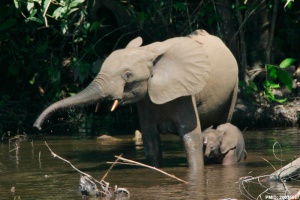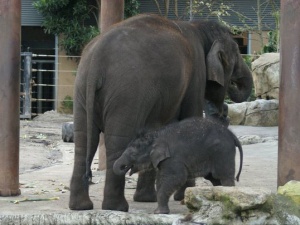Elephant Development: Difference between revisions
mNo edit summary |
mNo edit summary |
||
| Line 1: | Line 1: | ||
==Introduction== | ==Introduction== | ||
[[File:African elephant cow and calf.jpg|300px|thumb|alt=African elephant cow and calf|African elephant cow and calf]] | [[File:African elephant cow and calf.jpg|300px|thumb|alt=African elephant cow and calf|African elephant cow and calf]] | ||
* The average gestation age for elephants is 660 days. | |||
* An infant elephant is called a '''calf''' and a newborn can weigh 90 to 120 kilograms (198 to 264 pounds). | |||
** The calf suckles milk from its mother taking up to 12 litres each day. | |||
* Adult male elephant is called a '''bull''' and can weigh up to 6,800 kilograms (15,000 pounds). | |||
* Adult female elephant is called a '''cow''' and can weigh up to 3,600 kilograms (8,000 pounds). | |||
:'''Links:''' | :'''Links:''' | ||
| Line 23: | Line 30: | ||
|} | |} | ||
== Taxon == | == Taxon == | ||
[[File:Elephant and calf.jpg|thumb|Elephant and calf]] | |||
* African forest elephant - Loxodonta cyclotis | * African forest elephant - Loxodonta cyclotis | ||
| Line 33: | Line 41: | ||
:'''Links:''' | :'''Links:''' | ||
== Development Overview == | == Development Overview == | ||
Days below are post-ovulatory. | |||
* 50 days - embryonic vesicle earliest observation | |||
* 62 days - embryo detectable | |||
* 71 days - embryonic heartbeat and allantois visible as a single sacculation | |||
* 76 days - allantois subdivided in four compartments | |||
* 95 days - head, rump, front and hind legs distinguishable | |||
* 95 to 103 days - choriovitelline placenta was replaced by the chorioallantoic placenta | |||
* 95 to 116 days - midgut herniation | |||
Data from<ref><pubmed>18387665</pubmed></ref> | |||
==Additional Images== | ==Additional Images== | ||
Revision as of 14:15, 26 October 2014
Introduction
- The average gestation age for elephants is 660 days.
- An infant elephant is called a calf and a newborn can weigh 90 to 120 kilograms (198 to 264 pounds).
- The calf suckles milk from its mother taking up to 12 litres each day.
- Adult male elephant is called a bull and can weigh up to 6,800 kilograms (15,000 pounds).
- Adult female elephant is called a cow and can weigh up to 3,600 kilograms (8,000 pounds).
- Links:
| Animal Development: axolotl | bat | cat | chicken | cow | dog | dolphin | echidna | fly | frog | goat | grasshopper | guinea pig | hamster | horse | kangaroo | koala | lizard | medaka | mouse | opossum | pig | platypus | rabbit | rat | salamander | sea squirt | sea urchin | sheep | worm | zebrafish | life cycles | development timetable | development models | K12 |
Some Recent Findings
|
| More recent papers |
|---|
|
This table allows an automated computer search of the external PubMed database using the listed "Search term" text link.
More? References | Discussion Page | Journal Searches | 2019 References | 2020 References Search term: Elephant Development <pubmed limit=5>Elephant Development</pubmed> |
Taxon
- African forest elephant - Loxodonta cyclotis
- African savanna elephant - Loxodonta africana
- Asiatic elephant - Elephas maximus
cellular organisms; Eukaryota; Opisthokonta; Metazoa; Eumetazoa; Bilateria; Deuterostomia; Chordata; Craniata; Vertebrata; Gnathostomata; Teleostomi; Euteleostomi; Sarcopterygii; Dipnotetrapodomorpha; Tetrapoda; Amniota; Mammalia; Theria; Eutheria; Afrotheria; Proboscidea; Elephantidae; Loxodonta
- Links:
Development Overview
Days below are post-ovulatory.
- 50 days - embryonic vesicle earliest observation
- 62 days - embryo detectable
- 71 days - embryonic heartbeat and allantois visible as a single sacculation
- 76 days - allantois subdivided in four compartments
- 95 days - head, rump, front and hind legs distinguishable
- 95 to 103 days - choriovitelline placenta was replaced by the chorioallantoic placenta
- 95 to 116 days - midgut herniation
Data from[2]
Additional Images
Historic Images
References
Reviews
<pubmed></pubmed>
Articles
<pubmed></pubmed>
Books
Search PubMed
Search PubMed: Elephant Development |
External Links
External Links Notice - The dynamic nature of the internet may mean that some of these listed links may no longer function. If the link no longer works search the web with the link text or name. Links to any external commercial sites are provided for information purposes only and should never be considered an endorsement. UNSW Embryology is provided as an educational resource with no clinical information or commercial affiliation.
Glossary Links
- Glossary: A | B | C | D | E | F | G | H | I | J | K | L | M | N | O | P | Q | R | S | T | U | V | W | X | Y | Z | Numbers | Symbols | Term Link
Cite this page: Hill, M.A. (2024, April 24) Embryology Elephant Development. Retrieved from https://embryology.med.unsw.edu.au/embryology/index.php/Elephant_Development
- © Dr Mark Hill 2024, UNSW Embryology ISBN: 978 0 7334 2609 4 - UNSW CRICOS Provider Code No. 00098G




